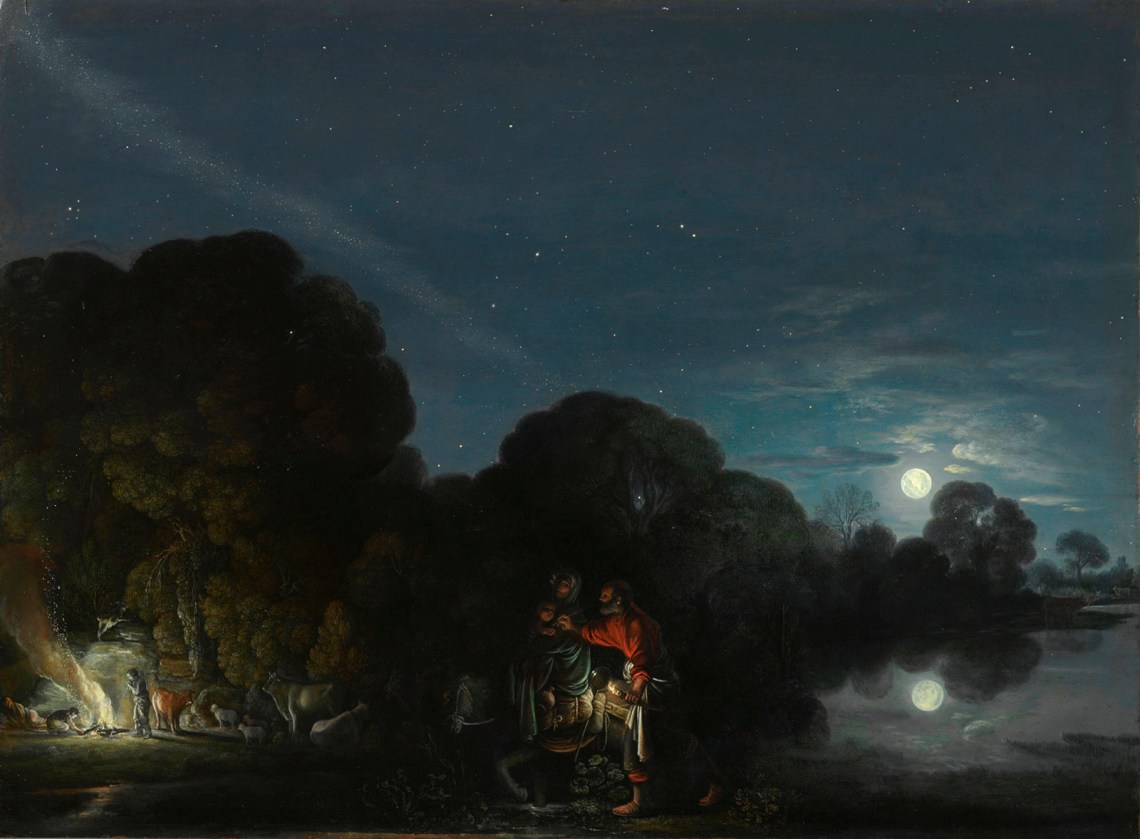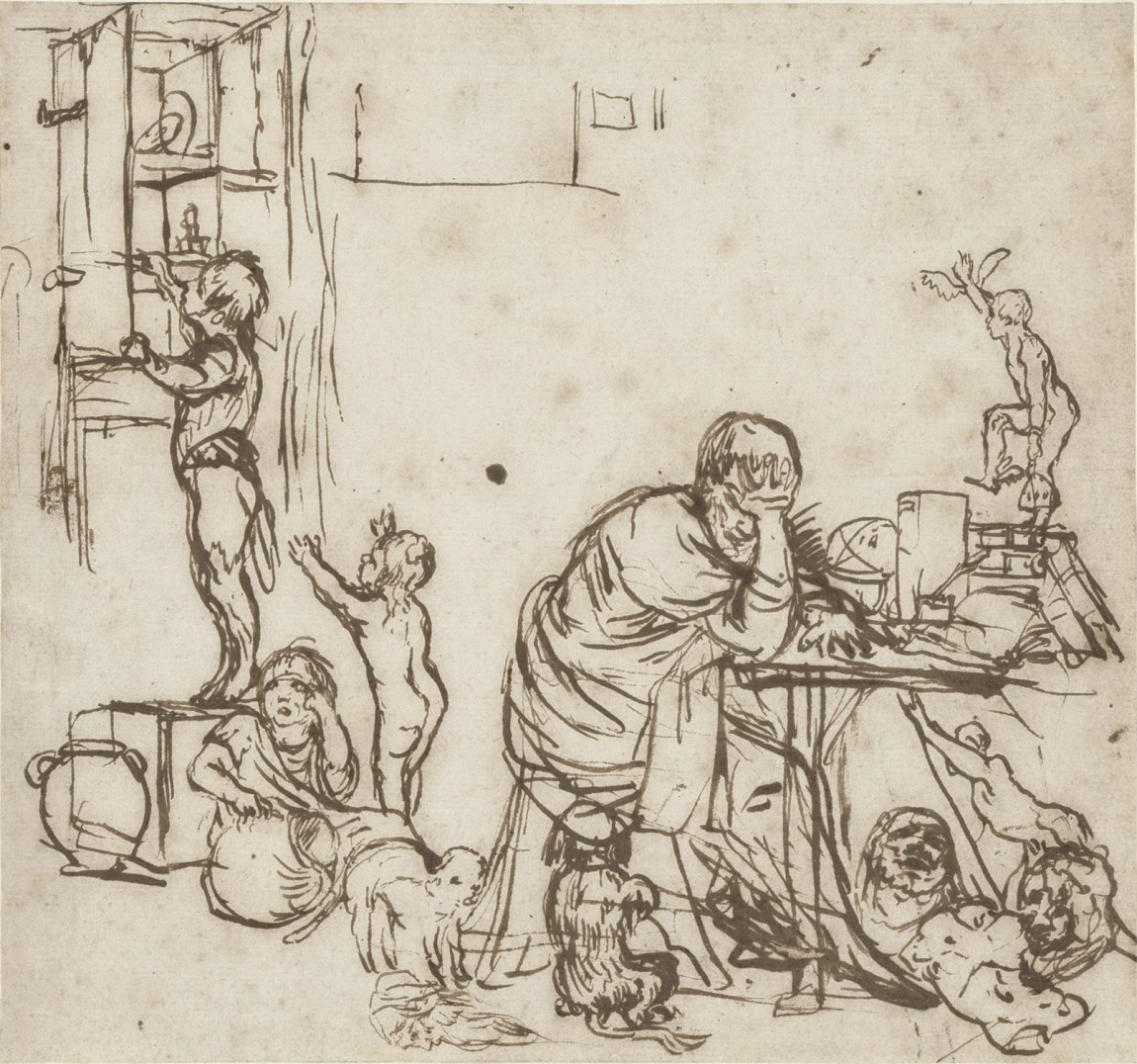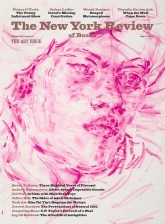In the nave of the Roman parish church of San Lorenzo in Lucina, a plaque was erected in 2010. It commemorates the burial there four hundred years before of Adam Elsheimer, a painter from Frankfurt who had arrived in Europe’s art capital in early 1600. The plaque belatedly salutes an artist’s artist who “opened the eyes of his time to the essence and beauty of nature.” This phrasing intrigues rather than explains—what previously unseen essence was that?—but what is sure is the impact of Elsheimer’s narrative compositions: those who leaned on them ranged from Claude Lorrain in Rome to Rembrandt in Amsterdam and the Mughal artist Payag in Agra. At the head of these admirers was Peter Paul Rubens, a fellow northerner who had likewise passed through the Porta Flaminia, Rome’s northern city gate (today the Porta del Popolo), and who went on to greater worldly success than his sometime friend in Rome. For Elsheimer was only thirty-two when he died—a loss mourned by Rubens in a letter written soon after.
“The tragedy of Signor Adamo,” as this letter describes it, was that of a matchless image inventor who became incapacitated by depression and who was then cornered by unrelenting creditors. What records we have suggest that during his final year, imprisonment for debt left Elsheimer more vulnerable to a stomach illness that dispatched him soon after his release. Consequently Carola, his widow, was left to face those creditors. Eight days after the funeral she led a notary around the couple’s shabby-genteel first-floor apartment on the Via del Babuino, directing him to what was probably her husband’s final work. “In primis,” the resulting inventory reads, “a painting on a sheet of copper, measuring around a palm and a half.” (Copper was Elsheimer’s preferred ground for his oil paintings, which were executed on sheets rarely larger than these sixteen inches.) “It depicts the Madonna and Saint Joseph when they went into Egypt with Jesus Christ their little son.”
The most valuable item in the apartment has remained the most celebrated item in Elsheimer’s oeuvre. His Flight into Egypt—now in Munich’s Alte Pinakothek—pictures the holy family making their escape from the wrath of King Herod “by night,” just as the Bible specifies: but by such a night as had never been painted before. Above the woods and lakeland through which Joseph conducts the donkey bearing Mary and little Jesus, vast gulfs of space open out. These skies, occupying over half the panel, are buttoned onto the ground-level world via the full moon’s reflection in the waters; the wisps of cloud that surround that bright disc and the irregular seas (or maria) with which its surface is pitted tie it closer to what’s textured and tangible.
But upward, finer and finer pinpricks of paint—Regulus, the Pleiades, Ursa Major, and Leo, the tiny receding light motes that make up the Milky Way—head out into the dizzily unreachable. When artists had looked upward before this, they seemed to see planets and constellations rotating around the earth on concentric, transparent shells of “crystal”: almost a century before, Albrecht Dürer had mapped the outermost of those spheres when he printed Europe’s first astronomical charts. Elsheimer’s cosmos, however, has become fathomless in depth. Beyond earthly objects, beyond even the stars, the panel posits an oceanic immensity.
On the back of the copper sheet, a faint signature with a date of 1609 seems to have been inscribed by the artist himself. It was in March of the following year that Galileo Galilei published Sidereus Nuncius, a pamphlet of “news about the stars” informed by observation. Readers across Europe were arrested partly by the scientist’s announcement that Jupiter possessed satellites, but also by his characterizations of the moon’s surface as “rough and uneven” and of the Milky Way as “nothing else but a collection of innumerable stars heaped together.” Putting forward these concrete assertions about heavenly bodies, Galileo’s pamphlet formed a decisive step in the great rethink of the universe that had begun when Copernicus issued his heliocentric hypothesis in 1543 and that was effectively completed when Isaac Newton produced a theory of celestial movements in his Principia (1687). An inference about the Flight into Egypt follows, and the plaque in San Lorenzo puts it forward as Elsheimer’s second claim to distinction, alongside his impact on his colleagues: “In 1609 he depicted the starry sky, observing it with one of the first telescopes.”
The panel, that is to say, should be saluted as a visual proclamation of the Scientific Revolution. The Flight into Egypt’s relation to new practices of observation seems underlined by a computer simulation published in 2005 by Gerhard Hartl and Christian Sicka: “On 16 June 1609, at around 9.45 PM, we found that the moon and the Milky Way would be in the position shown by Elsheimer.” Is this, then, the fittest setting of the Flight into Egypt—as a witness to humanity’s developing grip on nature and indeed on nature’s “essence”? Can we speak here of the art of painting acting as a doorkeeper to science? The history traced in Natural Light, my new book about Elsheimer, turns out to be not only more convoluted but more vertiginous and haunted.
Advertisement
One route into it might be to examine the claim that the painter used a telescope. This was indeed a novel device in 1609. Sometime the previous year a spectacle maker in the Netherlands named Hans Lipperhey discovered that a convex lens fixed into alignment with a concave one at either end of a tube could deliver a clearer and larger image to the viewer than the naked eye alone. The first we hear of the results is in a report on a parley held in September 1608 between warring generals: Ambrogio Spinola, commander of the armies of the Catholic Southern Netherlands, and Prince Maurice of Nassau, stadtholder of the United Provinces. “I shall no longer be safe, because you can see me from afar”—thus the former to the latter. “We shall forbid our men to shoot at you”—thus the mock-chivalrous smirk of his opponent.
The Dutch had been attempting to impress their enemies by demonstrating their new technology for tracking distant field movements, but it hardly needs saying that soon it was Spinola who was smirking. He had managed to acquire one of the cunning devices, and he lost no time in getting copies made, not only for his soldiers but as gifts for friends abroad. Another potential use might interest them, for as the report of that parley had noted, you could equally look up from the horizon: “Even the stars which ordinarily are invisible to our sight and our eyes, because of the smallness and the weakness of our sight, can be seen by means of this instrument.”
Over the following months specimens of the viewing machine arrived in England, France, and Germany. No later than May 1609, a telescope was in Rome and in the hands of the pope’s nephew Cardinal Scipione Borghese, the most acquisitive of the city’s cultural grandees. It is plausible, knowing the circles in which Elsheimer moved, that it was within reaching distance if the painter happened to be looking skyward on the night of June 16. What would he have seen, however? A 2021 paper by the historian of science Stefan Zieme takes a chisel to the inscription on the plaque installed eleven years before. Zieme ascertained that telescopes assembled according to Lipperhey’s initial model could magnify to only around the power of three. At that visibility, you cannot decisively interpret the blurry band of brightness that comprises the Milky Way. What you observe might, as some opined, be a cloudlike luminous condensation, or might, as others argued, consist of a swarm of distant stars: in the Rome of 1609, no clinching visual evidence was as yet obtainable.
When the painter interpreted the galaxy as a receding myriad of points of light, he was not therefore relying on a telescope. And if Elsheimer also depicted the moon with a pitted surface, he was only reporting an appearance always available to the eye of anyone well-sighted—although remarkably, he seems to have been only the third painter to do so, his distinguished predecessors being Jan van Eyck and Leonardo.1 When Galileo, however, wrote in his publication of March 1610 about stars “heaped together” to form the Milky Way and about “bumps,” “holes,” and “chasms” on the moon, these statements rested on an altered basis of information. The Padua-based scientist, having received his first specimen of a telescope in August 1609, had at once set to work with the lens makers of Murano to improve the device’s magnification. By midwinter, his sky-watching equipment had become superior to that of any rival—sufficiently so to allow for decisive analyses of that band of blur and of lunar topography. If, then, the assertions of Galileo’s 1610 Sidereus happen to converge with Elsheimer’s 1609 pictorial vision, there is no direct causal relation. The two stargazers could not have met: they were working in different cities.
Coincidence, however, this was not. Astronomy was to European minds of this era what geology would become in the nineteenth century, the age of Lyell and Darwin: an intellectual Wild West, a frontier for free-ranging speculation. Many a writer has examined how the initiatives of scientific pioneers—above all, Galileo and his near-contemporary Johannes Kepler, working in the footsteps of Copernicus and Tycho Brahe—combined to open up a larger universe. But what stake in this process did the painter from Frankfurt have? Elsheimer was the son of a high-class tailor in a city that, then as now, served as a nexus for Europe’s book trade. Opting for a parallel line in refinement—the small “cabinet picture” that a gentleman might savor in his study—he looked up, as an apprentice, to the work of Dürer, dead fifty years before his own birth in 1578. Travels in southern Germany introduced him also to Albrecht Altdorfer, another Renaissance innovator. Rome was the destination of those travels because it was there, all agreed, that an ambitious artist stood to learn most; and though his format was diminutive, Elsheimer’s ambitions were large indeed.
Advertisement
The art of his great German predecessors—for instance those star charts of Dürer’s or his Great Piece of Turf (1503) and Melencolia I (1514), or Altdorfer’s panoramic Battle of Alexander at Issus (1529)—was a picturing intent to investigate all there was to know. The art Elsheimer encountered once he crossed the Alps flaunted lofty visual harmonies, founded in antiquity and upheld by figure painters down to the yet active Annibale Carracci. Entering the Porta Flaminia and settling down in the nearby immigrant quarters, the newcomer hit on a distinctive way of keeping both objectives—truth and beauty—in view: namely, by mnemonic compression, employing one or another of the information-filing techniques available in the era’s self-help publications. As Elsheimer explained in the only artist interview we possess (recorded secondhand in Karel van Mander’s 1604 Schilder-boeck), his method was to “fix everything fast inside his mind” rather than on paper, whether he was studying the art or the scenery around him. The plaque in San Lorenzo needs amending, then: it was a telescope of memory, not of brass and glass, that Elsheimer used to transcribe the Flight into Egypt’s constellations. That in fact was the conclusion Hartl and Sicka arrived at, after attempting their computer simulation. They discerned a feat of imaginative distillation rather than of point-for-point accuracy.
One of Elsheimer’s rare drawings proclaims at once the potency and—to take a cue from Rubens—the “tragic” liabilities of this approach. The penwork of The Artist in Despair (circa 1606–1608) has the brusque urgency of a mind brimming over, one scratch unleashing another in a self-correcting reverie like those we see in the drawings of Rembrandt. This is a satire of sorts, nodding to earlier satires on intellectual hubris—Dürer’s Melencolia I and Pieter Bruegel’s The Alchemist (after 1558), from which Elsheimer has adopted the motif of the improvident knowledge-seeker’s three hungry children. Carola and Adam had only one—yet unmistakably, it is his own indebted predicament that he berates.
By the time of this drawing, the onetime self-confident aspirant had shaded, in the eyes of acquaintances, into a brooding problematizer, and he was leaning for loans on Hendrick Goudt, a moneyed young printmaker who disseminated his compositions and who ended up taking him to court, becoming the cause at once of his fame and of his ruin. And thus, behind that headache-inducing foreground—the melancholic artist’s desk with its summons to mental struggle, its globe, tomes, and statuettes—the cupboard and indeed the whole cellar are bare, prompting questions hard to answer. Why is he condemned to cogitation, in all its restlessness? What place is there for mind, in all that unheeding space?
And these are the questions that the Flight into Egypt repositions cosmologically. Elsheimer frequented learned company. He and his sophisticated friend Rubens dined with other northerners who had footholds in Rome: the pope’s scientific consultant Johann Faber and the acerbic Catholic propagandist Caspar Schoppe. Faber corresponded in turn with Galileo, for whose mathematically oriented science he would later become an advocate. But all the while there was a ghost at their table. In February 1600, likely a few weeks before Elsheimer’s arrival in Rome, a papal court had ordered the burning in the Campo de’ Fiori of a thinker whose thoughts had proved heretically excessive. Giordano Bruno had been roving Europe in the previous two and a half decades, dazzling and infuriating listeners with his outlandishly novel ideas.
Like Elsheimer, Bruno looked to mnemonics as an intellectual master key, but his most reckless move was to take Copernicus’s decentering of the earth to its logical conclusion. There could, Bruno argued, be no center to the universe, for the skies we look up into are literally infinite. Each point of light may be another sun around which circle further planets, upon which further sentient beings may walk, and to this multiplicity of creation there can be no limit. No compass-point supremacy, therefore, for humankind—nor for its savior, nor for his church. The unease caused by such a radical dislocation may be gauged by the venom of Schoppe’s eyewitness report on Bruno’s execution: “Thus he miserably burned, and now probably dwells [in] those other Worlds he invented.”
Bruno’s vision threatened because it left no ground on which to stand: it swept away the primacy of “here,” of a stable earthly place, leaving mere directionless space. It was left to Galileo to offer an alternative, more abstract bedrock for the mind when he argued in his Dialogue Concerning the Two Chief World Systems (1632) that by understanding the mathematics that underlie the cosmos, our knowledge becomes “equal to divine knowledge in objective certainty, because it gets to understand necessity, beyond which nothing can be surer.” But science as we have since known it—the paradigm that Galileo was effectively proposing—is not actually the business of the Flight into Egypt. This composition of Elsheimer’s follows others in which he puzzled over the interrelation of figures and environment through subtle reflections on chosen texts, and here his text concerns a being who is at once a vulnerable infant and the sustainer of the universe.
At one end of the scale, then, Elsheimer conceives the acutest intimacy: the eyes of mother, child, and Joseph interlocked in a fond private exchange as their donkey, laden with pans and blankets, splashes through the wetlands. At the other, there is immeasurable, formless space—the “fluid heavens” that Tycho Brahe had recently proposed as a replacement for the crystal spheres. Above and below relate—not solely via the moon’s reflection, but via the trail of sparks from the shepherds’ bonfire that is shown on the left and that forms an analogue to the Milky Way’s trail of stars. (A “craftsmanlike fire”: that is how Justus Lipsius, a philosopher favored by the diners chez Faber, liked to characterize the world’s creator.2)
But just as those shepherds are making their camp in the cold of the night, so the foreground travelers are refugees. In this new vision of nature and of how we are placed in the cosmos, there is the possibility of homeliness—the possibility of “here”—but it can only be provisional. Elsheimer observes, memorizes, and points his squirrel-hair brush—stars and ever fainter stars—to celebrate what is: his painting is affirmative, as any investigation of visible nature is bound in a sense to be. Yet what is, is strange. Space is too large to claim as our home, and if at this juncture between world systems humans seek a divine in which to trust, it shimmers before them not in the necessary truths of mathematics but in awe-suffused perplexity. Francis Bacon, ideologue to the emerging Scientific Revolution, urged in 1605 that our awe at God’s creation should prompt us to seek reliable understandings of the world. We should not stand stalled by mere wonder, a state of mind that is no more than “broken knowledge.” Yet that brokenness—so the artist senses—might hold the larger truth.
-
1
See the moon represented to the right of the cross in Van Eyck’s The Crucifixion (circa 1440–1441) and drawings in a notebook of Leonardo’s. ↩
-
2
Lipsius was in fact citing Zeno, the founder of the Stoic school, who is quoted by Diogenes Laërtius in his Lives and Opinions of Eminent Philosophers (7.156) as invoking a pyr technikon. ↩





